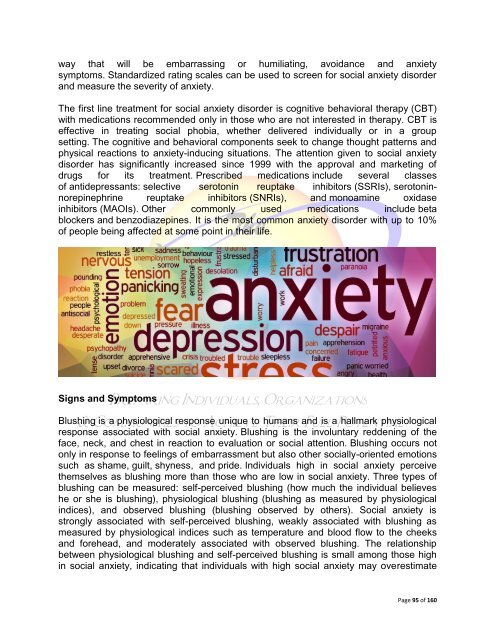The Gift of Introversion
The Gift of Introversion
The Gift of Introversion
You also want an ePaper? Increase the reach of your titles
YUMPU automatically turns print PDFs into web optimized ePapers that Google loves.
way that will be embarrassing or humiliating, avoidance and anxiety<br />
symptoms. Standardized rating scales can be used to screen for social anxiety disorder<br />
and measure the severity <strong>of</strong> anxiety.<br />
<strong>The</strong> first line treatment for social anxiety disorder is cognitive behavioral therapy (CBT)<br />
with medications recommended only in those who are not interested in therapy. CBT is<br />
effective in treating social phobia, whether delivered individually or in a group<br />
setting. <strong>The</strong> cognitive and behavioral components seek to change thought patterns and<br />
physical reactions to anxiety-inducing situations. <strong>The</strong> attention given to social anxiety<br />
disorder has significantly increased since 1999 with the approval and marketing <strong>of</strong><br />
drugs for its treatment. Prescribed medications include several classes<br />
<strong>of</strong> antidepressants: selective serotonin reuptake inhibitors (SSRIs), serotoninnorepinephrine<br />
reuptake inhibitors (SNRIs), and monoamine oxidase<br />
inhibitors (MAOIs). Other commonly used medications include beta<br />
blockers and benzodiazepines. It is the most common anxiety disorder with up to 10%<br />
<strong>of</strong> people being affected at some point in their life.<br />
Signs and Symptoms<br />
Blushing is a physiological response unique to humans and is a hallmark physiological<br />
response associated with social anxiety. Blushing is the involuntary reddening <strong>of</strong> the<br />
face, neck, and chest in reaction to evaluation or social attention. Blushing occurs not<br />
only in response to feelings <strong>of</strong> embarrassment but also other socially-oriented emotions<br />
such as shame, guilt, shyness, and pride. Individuals high in social anxiety perceive<br />
themselves as blushing more than those who are low in social anxiety. Three types <strong>of</strong><br />
blushing can be measured: self-perceived blushing (how much the individual believes<br />
he or she is blushing), physiological blushing (blushing as measured by physiological<br />
indices), and observed blushing (blushing observed by others). Social anxiety is<br />
strongly associated with self-perceived blushing, weakly associated with blushing as<br />
measured by physiological indices such as temperature and blood flow to the cheeks<br />
and forehead, and moderately associated with observed blushing. <strong>The</strong> relationship<br />
between physiological blushing and self-perceived blushing is small among those high<br />
in social anxiety, indicating that individuals with high social anxiety may overestimate<br />
Page 95 <strong>of</strong> 160

















